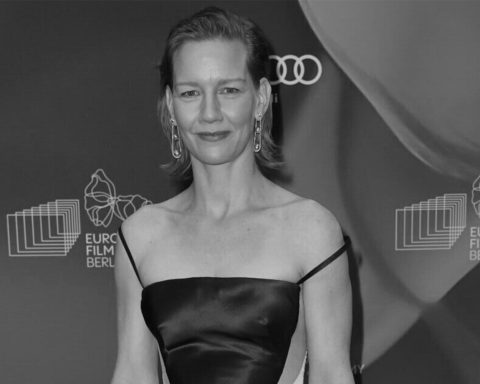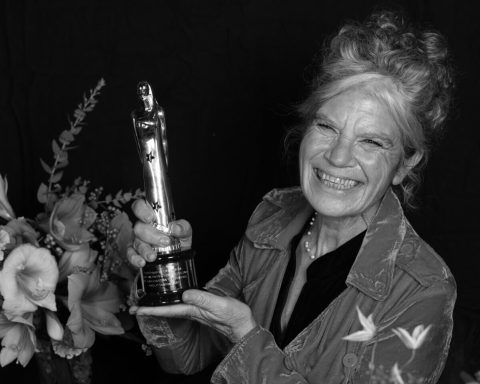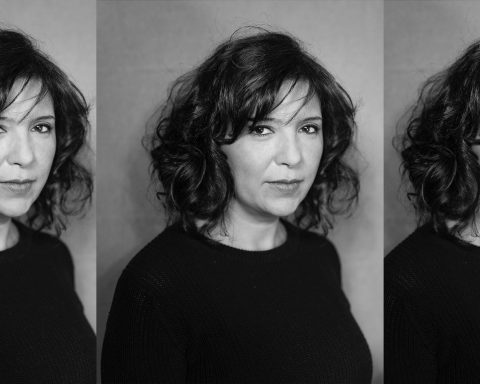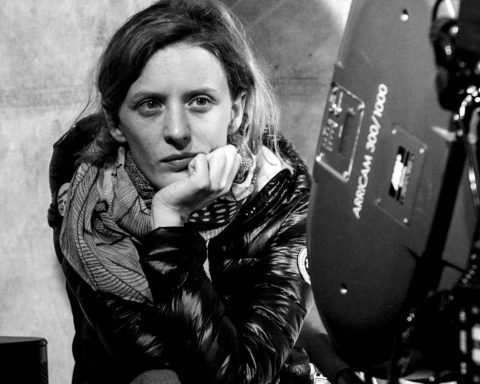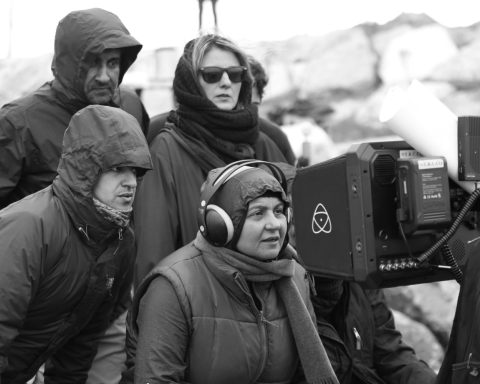Ena Sendijarević is a Bosnian-Dutch filmmaker. She studied Film Studies at the University of Amsterdam and the Freie Universität Berlin, before graduating from the Netherlands Film Academy as a writer/director in 2014. She directed several short films like “Travelers into the Night” (2013) and “Fernweh” (2014). Her latest short “Import” premiered in the Directors’ Fortnight strand at the 2016 Cannes Film Festival and traveled to numerous film festivals ever since. It was the official Dutch Short Film entry for the 2017 Academy Awards. “Take Me Somewhere Nice” is Ena’s debut feature film. It premiered in the Tiger Competition at the 2019 International Film Festival Rotterdam, where it won the Special Jury Award for Exceptional Artistic Achievement. It was selected for Cannes ACID and took home the Heart of Sarajevo for Best Film at the 2019 Sarajevo Film Festival.
Tara Karajica caught up with Ena Sendijarević at the aforementioned festival.
In Take Me Somewhere Nice, you tackle the relationship between migrants and their home country. How did the film come about?
Ena Sendijarević: I wanted to explore this relationship between the immigrant and the home country because I think it’s one of the most complex relationships there is. Coming from Bosnia and having lived in the Netherlands for twenty-five years, I wanted to make a playful and rebellious film about this schizophrenic, in-between state of mind, to express this estranged state of being cinematically. Through a very simple plot line – a Dutch girl spending a summer in Bosnia, her country of origin – I wanted to explore East/West and male/female dynamics.
There are absurd situations and encounters through which you show that it’s possible to tackle the evidently serious issue of migration with (deadpan) humor. Can you talk about that and the humor’s place and role in the film?
E.S.: The humor and stylized world are part of the Brechtian approach to the social issues the film is addressing. Brecht calls this the “Verfremdungseffekt.” It means showing situations that are familiar, stereotypical even, and then, through the use of humor and stylization, making an estrangement possible from the situations portrayed. In this way, the audience understands that the situations portrayed are not inevitable. The filmmakers have constructed them. Just like society itself is a construction and, if it doesn’t work, it can be changed. The form of the film is trying to make this “construction” tangible, but at the same time I tried to make the film watchable as well. A film has to be entertaining, too. During the making of the film, it was a constant search for the balance between these two. Furthermore, I think humor can be used in the process of acceptance and moving forward in life. Think of the laughter that sometimes comes after crying with a friend: it’s liberating! You laugh about the stupidity or absurdity of your own situation and this helps you move forward. That’s exactly what I wanted to achieve with Take Me Somewhere Nice as well. I was looking for a tone of voice that would be empowering.
Remaining with the absurd, you highlight it through your filmmaking style as well – in the style, with unusual camera angles, pastel colors, the Academy aspect ratio that is reminiscent of Instagram and a new generation, kitsch elements but also a minimalist production design. Can you talk about these choices and the part they play in the construction of reality as one absurd possibility?
E.S.: It was important to me to make a film that would feel “here and now,” that would use the visual language of a new generation. This is how these Instagram aesthetics came about. With my team, especially my DoP, Emo Weemhoff, and production designer, Myrte Beltman, we searched for a visual language that would be humorous, going against the limiting and boring idea of what makes up “good taste.” The kitschy elements became part of the humor, because they are part of a stereotypical view on the Balkans. Instead of avoiding them, I wanted to play with them and subvert them.
In what way did Jim Jarmusch, Fassbinder and Brecht inspire you in the creation of this film, or this construction, if you will?
E.S.: Jarmusch and Fassbinder are clearly influenced by the works of Brecht. But Brecht was mainly focused on theater. Fassbinder, coming from theater, translated Brecht to the screen in a very beautiful way. Angst essen Seele auf is one of my favorite films. It deals with xenophobia and racism in Germany in the times of the gastarbeiter in such a rebellious and truthful way. Jarmusch’s Strangers in Paradise uses different cinematic tools to achieve the same Brechtian effect. It was the first film I saw where I truly recognized something of this feeling of in-betweenness of the marginalized. These films have had a very big impact on me and on the coming about of Take Me Somewhere Nice.
You delve into many themes like identity, migration, East/West tensions in this film. Can you elaborate on that?
E.S.: These are themes that not only play a big part in my own life, but also in today’s world. The continuing refugee crisis combined with globalization and the effects of the digital revolution have put a lot of pressure on the way we deal with migration issues. The rise of nationalism everywhere is a very tangible result of that. People want to go back to a time where things were “clear.” But “clear” can sometimes mean black and white, without nuances, binary, oversimplified. That’s not how the world works. I wanted to touch upon these subjects and embrace the ambiguity and complexity of it all. To make a safe haven, where it is okay to be confused, where it is okay not to have answers immediately. I think it is the responsibility of art to create these safe havens.
Can you talk about the casting process and working with Timka Grin and Rebecca van Unen and casting first-time actors on this project?
E.S.: It was a long process. It was very nice to be able to lean on the experience of Timka and Rebecca, especially when I got scared and started doubting whether I could pull these first-time actors through the film. Rebecca immediately knew Sara Luna was the one. Still, we saw many other girls and even did some tests with young Dutch actresses. Likewise, with Timka, we saw many, many actors. They both had a lot of patience with me as a first-time feature director. Even if they would intuitively know where we were heading, they would give me all the space and time to explore further. I am really happy I had the honor to work with them.
Would it be fair to say that Bosnia is also a character in this film?
E.S.: I don’t think so. I don’t think it’s possible to represent a whole country in a film. But I would say that the diversity of Bosnian nature could be a character.
Can you talk about your antihero protagonist, Alma? How do you see her?
E.S.: She has many antihero qualities: she’s lazy, bored, naïve, reckless, selfish. This makes her a funny protagonist and sometimes a bit annoying as well. But to me, she is also a hero because her behavior goes against what is expected of a woman in our patriarchal societies. She is not obedient and sweet; she’s not a pleaser. While writing her, I took comfort in what Jane Austen said when she was writing her main character for Emma. She said: “I am going to take a heroine whom no one but myself will much like.” I wanted to do the same. As it turns out, there are a lot of people who do like Alma. After screenings, mainly women came up to me saying that they recognize themselves in her, that they recognize this risk-taking, sexual and reckless energy that we have to hide in order to fit into the patriarchal system. They feel liberated watching Alma.
Weren’t you concerned about being identified by the audience as her?
E.S.: This would mean that I would be ashamed of her. I am not. Take Me Somewhere Nice is not my life story. I just used some ingredients of the worlds that I grew up in. The triangle Alma-Denis-Emir stands for a West/Eastern European relationship. There is a lot of symbolism in this film; surrealism as well. My life looks very different to Alma’s. The decisions that I made while building my characters had to do with the kind of film that I wanted to make. I don’t think my autobiographical life story is interesting enough to make a film about.
How personal was it for you to talk about the complexity of being both Bosnian and Dutch, without one overpowering the other?
E.S.: I think cinema should be personal. Which is something different than autobiographical. The relationship between the person behind the camera and the world portrayed before it is a power relationship. Now that most of us have access to a camera and a platform where we can show our footage, this power relationship is becoming more tangible. I think it’s more honest to be clear about your subjectivity as a filmmaker, as a manipulator.
About the complexity of being Bosnian and Dutch: I wanted to show that being part of two nations does not mean you are wearing two fixed national identities that are fighting each other. I wanted to show how layered this sense of identity is, how it works on so many different levels. Nationality, gender, sexuality, ethnicity; they all play a role in it.
Take Me Somewhere Nice builds on your three previous shorts, especially the critically acclaimed Import, in terms of style and themes. Can you comment on that?
E.S.: Before making Import, I never wanted to use cinema to talk about political issues in a direct way. My two first shorts are more allegorical and they don’t deal with the real world or with specific countries in a direct way. They could’ve taken place anywhere. When the refugee crisis started in 2015, it politicized my work. I sought for a way to join the discussion. I wanted to use my own experiences as a refugee, but without falling into this trap of self-victimization. This is how I found the form for Import. The form came before the story. In Take Me Somewhere Nice, we have pushed further in this direction. But I think Take Me Somewhere Nice is more provocative than Import, especially because of the way it deals with sexuality.
It also shows another way of depicting social traumas of the post-war period, which is very important. Can you expand on that?
E.S.: Like mentioned before, I think laughter is a very important part of the healing process. Also, cutting loose from a victimizing way of looking at your own situation can be empowering. At least, it is for me. The film is dealing with the situation of Bosnian society today. If it wasn’t for the Dayton agreement that is still tearing the country apart, facilitating segregation, Bosnia would have been on its feet already. It’s the current governmental system that is making it impossible for the new generation to build a future as 60 % of them are unemployed. I wanted to empower them, just like I wanted to empower people living in-between nations, in-between cultures.
Can you talk about the title? Where is “somewhere nice”? Is it the place where you accept your “double” identity?
E.S.: Take Me Somewhere Nice is referring to this human desire of being somewhere else where things are better. I guess it’s a desire at the base of migration, be it voluntary or involuntary. All the refugees and economical immigrants that are coming to Western Europe think it’s a place where things are good, where things are nice. Unfortunately, for most of them, it turns out to be a Fata Morgana. So the title had more to do with these streams of migration, than that it has to do with this question of identity.
Who is your favorite female filmmaker? And your favorite film by a female filmmaker?
E.S.: There are so many! I want to name three of them: Liliana Cavani and her Night Porter, Věra Chytilová with Daisies and, of course, Agnès Varda with La pointe courte. All three of them are geniuses and big inspirations to me.
What is your opinion on the situation of women in film today?
E.S.: I am happy that we are becoming more and more aware of the history of cinema being full of forgotten women and that we have started to rewrite it. Agnès Varda is finally getting recognition for making the first Nouvelle Vague film, pioneers like Alice Guy-Blaché are finally being brought back from invisibility. We are talking more about the ongoing inequality – that’s very good! At the same time, things are changing very slowly. I think it’s important to keep on talking about the male-female balance, not to think the battle for equality is over, not to think it will solve itself. It won’t. We have to keep pushing! Talking about male-female equality in the film industry always brings up concerns about the quality of the work. But who gets to decide what quality is? Talking with my audiences in the last years, I can easily feel how gender – and background – plays a crucial role in the understanding of a film. If a male decision-maker doesn’t pick up on certain layers in a film directed by a woman, does this mean it’s a bad film? Again, these are questions of power…
What are your next projects?
E.S.: I am making an absurdist, fantastical film about the Dutch colonial experience in 1900, seen from a female perspective. It’s set on a desolate island in Indonesia, where two Dutch women have to survive. After having explored my relationship with my country of origin, I feel the desire to explore the history of my home country of the last twenty-five years. Again, I will explore East/West relationships and male-female tensions.
This interview was conducted at the 2019 Sarajevo Film Festival.
Photo credit: Imke Panhuijzen





